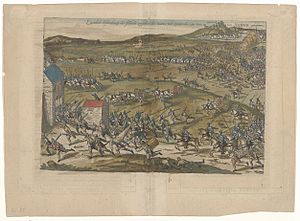
Back Batalla de Gembloux Catalan Batalla de Gembloux Spanish Bataille de Gembloux (1578) French Battaglia di Gembloux (1578) Italian Slag bij Gembloers (1578) Dutch Bitwa pod Gembloux Polish Битва при Жамблу Russian
| Battle of Gembloux | |||||||
|---|---|---|---|---|---|---|---|
| Part of the Eighty Years' War | |||||||
 Engraving of the Battle of Gembloux by Frans Hogenberg | |||||||
| |||||||
| Belligerents | |||||||
|
|
| ||||||
| Commanders and leaders | |||||||
|
Martin Schenck Emanuel Philibert de Lalaing Count of Egmont Marquis d’Havré Henry Balfour |
| ||||||
| Strength | |||||||
| 20,000 men |
17,000–20,000[2] (Only engaged 1,200 cavalry in the first phase of the battle)[3] | ||||||
| Casualties and losses | |||||||
|
6,000 killed [2] Hundreds of prisoners[2] |
20 dead or wounded (12 dead in action)[3] | ||||||
The Battle of Gembloux took place at Gembloux, near Namur, Low Countries, between the Spanish forces led by Don John of Austria (Spanish: Don Juan de Austria),[4] Governor-General of the Spanish Netherlands, and a rebel army composed of Dutch, Flemish, English, Scottish, German, French, and Walloon soldiers under Antoine de Goignies,[5] during the Eighty Years' War.[1][2] On 31 January 1578 the Spanish cavalry commanded by John's nephew, Don Alexander Farnese, Prince of Parma (Italian: Alessandro Farnese, Spanish: Alejandro Farnesio), after pushing back the Netherlandish cavalry, attacked the Netherlandish army, causing an enormous panic amongst the rebel troops.[3] The result was a crushing victory for the Spanish forces.[1][2] The battle hastened the disintegration of the unity of the rebel provinces, and meant the end of the Union of Brussels.[6][7]